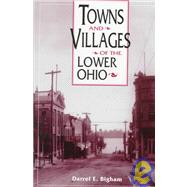Towns & Villages of the Lower Ohio
, by Bigham, Darrel E.- ISBN: 9780813120423 | 081312042X
- Cover: Hardcover
- Copyright: 12/11/1997
" America. Enterprise. Metropolis. Cairo. Rome. These are a few of the grandly named villages and towns along the lower Ohio River. The optimism with which early settlers named these towns reveals much about the history of American expansion. Though none became the next great American city, it was not for lack of ambition or entrepreneurial spirit. Why didn't a major city develop on the lower Ohio? What geographic, economic, and cultural factors caused one place to prosper and another to wither? How did Evansville become the largest and most influential city in the region? How did smaller cities such as Owensboro and Paducah succeed? Regardless of how appealing a locale looked on the map, luck, fate, culture, and leadership all helped determine success or failure. The fate of Cairo, Illinois -- on paper an ideal site for a metropolis -- emphasizes the extent to which human decisions, rather than physical landscape, affected a town's prosperity. The location of a canal or railroad terminus, the construction of a factory, or the activities of local boosters all mattered greatly. Darrel Bigham examines these towns and villages from the 1790s, when the first settlements appeared, to the 1920s, when the modern pattern of life associated with automobiles, economic upheaval, and mass culture emerged. Bigham's intimate knowledge of the area offers a true sense of the towns and villages and discloses fundamental truths about the workings of the American dream.






